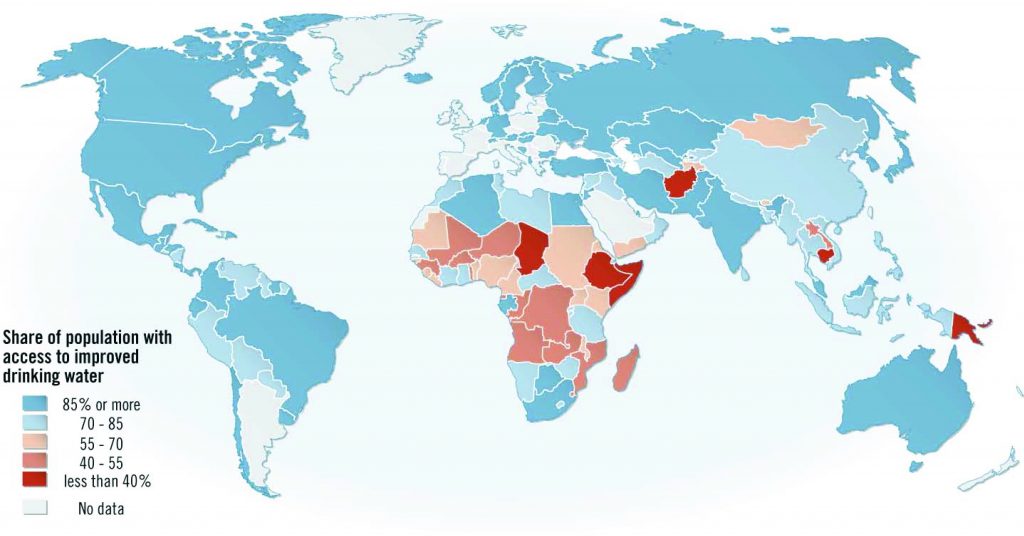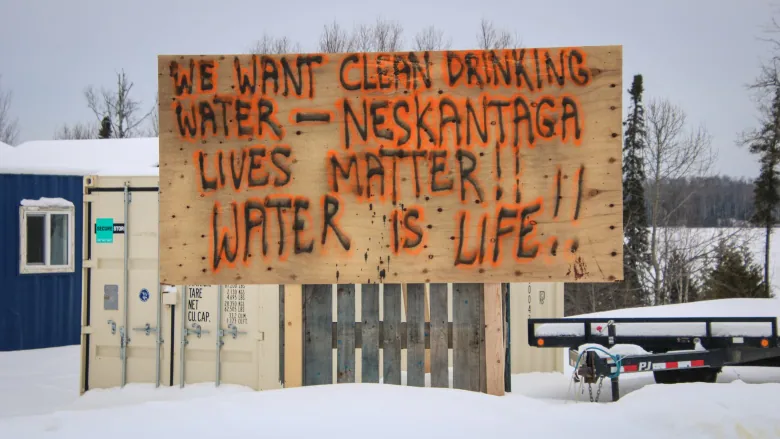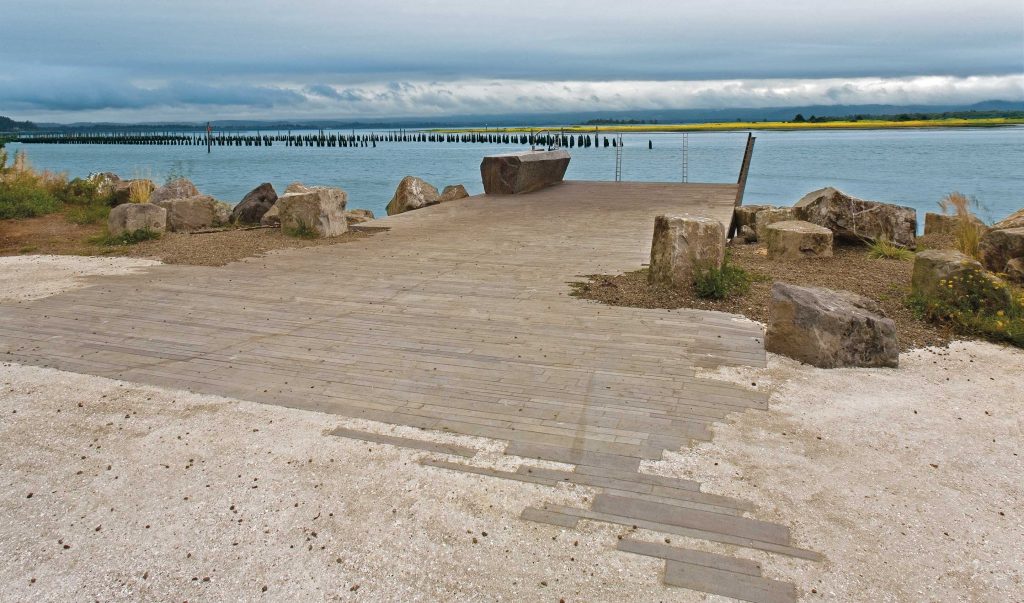Access to clean drinking and water is an issue of life or death for many across the globe. Beyond this, access to healthy salt and freshwater ecosystems are important for food, wellbeing, hygiene, and cultural significance. Issues of power, jurisdiction, drought, pollution, and conflict result in billions of people around the world that do not have the access to water that they need. Even countries that are considered wealthy or affluent have serious issues of water ethics occurring today. As landscape architects and designers, viewing the complexity of humankind’s relationship to water in the landscape from a sociological and justice perspective should critically inform our practice.
What are some examples of current water ethics issues?
World Health Organization (WHO) estimated in 2019 that 1/3 of people globally – or 2.2 billion people – do not have access to clean water for drinking1. Lack of clean drinking water has been shown to perpetuate further inequalities: for example, UNICEF and WHO have found that women and girls in areas without nearby water sources are significantly more likely to be responsible for retrieving water often over significant distances, both putting them at risk and taking their time away from work, education, and family2.

Figure 1: Share of Population with Access to Improved Drinking Water Map. ReliefWeb.
For areas of the world that struggle with significant drought along with poor access to potable water, climate change has the potential to add additional stress to water supplies, further exacerbating existing inequalities. Establishment of infrastructure, policies, and practices now that will provide people with life-giving water during future extreme heat and drought is an urgent need3.
It is often assumed that lack of potable water is an issue exclusively experienced in developing countries, however this is not true. In Canada, there are ongoing boil water advisories in indigenous communities that in some cases have lasted decades, even in communities immediately adjacent to significant cities. According to one 2019 article, people living on First Nations reserves are 90 times more likely to be without running water than people living elsewhere in the country, and are also significantly more likely to experience water-borne illnesses4. Federal government promises to solve this extensive issue by 2021 were not kept, and many communities are still without clean drinking water.

Figure 2. Sign at Neskantaga First Nation, Ontario. CBC.

Figure 3. Advisories for seafood consumption at the Duwamish River, Seattle. This now highly contaminated Superfund site has been relied upon for food by the Duwamish people for thousands of years. KUOW/John Ryan.
Beyond drinking water, access to shorelines is a global issue beset by injustice and inequality. For example, In urban New York and New Jersey, lack of access to the shore is most likely to be experienced by those living in the poorest neighbourhoods5.
These are just a few of the contemporary issues of water equity, covered in brief. Please be sure to research issues specific to the location and time of your project. It is also important to understand any history of water inequity that may still be impacting and site and the people who engage with it. Explore the following areas for a holistic picture: Drinking water, recreational access, cultural access, and water quality.
1. “1 in 3 People Globally Do Not Have Access to Safe Drinking Water – UNICEF, WHO.”
2. “Drinking-Water.”
3. “Water – at the Center of the Climate Crisis | United Nations.”
4. Swampy and Black, “Tip of the Iceberg: The True State of Drinking Water Advisories in First Nations.”
5. Mortice, “Everybody In.”
What role do landscape architects and designers play in promoting ethical access to water?
There are several areas in which Landscape architects, planners, and designers can promote just access to water in the landscape.
First, through awareness and education: this field has unique skills for visualizing and processing data on water in the landscape that can lead to better-informed policy decisions and practices that support equitable water use and access. Interpretive design interventions that reveal the invisible network of relationships with water on a site are an example of how this can be pursued. This first requires that the environmental designer is thoroughly knowledgeable about the issues at hand and committed to the process of learning and staying up-to-date.
Second, through activism: landscape architects and designers have platforms and relationships that can – and should – be leveraged to effect change.
Finally, through design: it is critical that our projects understand and reflect site-specific issues of justice, rights, and access to avoid perpetuating water injustice. This may manifest in interventions that clean contaminants from water bodies, provide physical access points for fishing, recreation, and washing or prioritize the rights and wellbeing of marginalized groups over the desires of powerful corporations and organizations.
Sources
“1 in 3 People Globally Do Not Have Access to Safe Drinking Water – UNICEF, WHO.” https://www.who.int/news/item/18-06-2019-1-in-3-people-globally-do-not-have-access-to-safe-drinking-water-unicef-who.
“Drinking-Water.” World Health Organization. https://www.who.int/news-room/fact-sheets/detail/drinking-water.
Mortice, Zach. “Everybody In.” Landscape Architecture Magazine, June 22, 2020. https://landscapearchitecturemagazine.org/2020/06/22/everybody-in/.
Swampy, Mario, and Kerry Black. “Tip of the Iceberg: The True State of Drinking Water Advisories in First Nations.” UCalgary News. https://ucalgary.ca/news/tip-iceberg-true-state-drinking-water-advisories-first-nations.
United Nations. “Water – at the Center of the Climate Crisis | United Nations.” https://www.un.org/en/climatechange/science/climate-issues/water.
Images:
Figure 1: “World: Access to Safe Drinking Water – World | ReliefWeb,” August 6, 2008. https://reliefweb.int/map/world/world-access-safe-drinking-water.
Figure 2: News ·, Olivia Stefanovich · CBC. “Ontario Should Stop Playing ‘jurisdictional Ping Pong’ with First Nations’ Water Crisis, Says NDP MPP | CBC News.” CBC, December 22, 2020. https://www.cbc.ca/news/politics/sol-mamakwa-ontario-government-neskantaga-1.5849929.
Figure 3: The Seattle Times. “Toxic Legacy of Seattle’s Only River Could Cost Boeing, Taxpayers $1 Billion. Talks over Who Pays More Are Secret,” September 24, 2023. https://www.seattletimes.com/seattle-news/times-watchdog/toxic-legacy-of-duwamish-river-could-cost-boeing-taxpayers-1-billion/.
Additional Resources
“Drinking-Water.” World Health Organization. https://www.who.int/news-room/fact-sheets/detail/drinking-water.
A concise fact sheet outlining global water issues through statistics. Links on the page provide potentially helpful avenues for more detailed research
Boelens, Rutgerd, Tom Perreault, and Jeroen Vos, eds. Water Justice. Cambridge: Cambridge University Press, 2018. https://doi.org/10.1017/9781316831847.
An extensive resource on water justice, providing a detailed, recent overview of issues facing us today around the world. This is a highly recommended read.
Precedents
Confluence: Maya Lin, others
Series of locations in Washington and Oregon, USA, along the Columbia River

Confluence is a combination of landscape architecture, art, and community engagement programs that seeks to restore a cultural connection and access “to the history, living cultures, and ecology of the Columbia River system through Indigenous voices”.
This project can be viewed here.
Rwampara Wetland: Rwanda Environment Management Authority
Kigali, Rwanda

As the city of Kigali expands rapidly, the wetlands that support agriculture and water access in the city have been compromised, also leading to flooding and other hardships in low lying areas. The Rwanda Environment Management Authority is in the process of supporting managed retreat from wetland areas in the city, while transforming the area around the wetland into biodiverse public space, promoting equitable water access and stewarding one of the cities greatest resources.
Study for the wetland rehabilitation can be found here. Also see “Kigali, Rwanda: city of hills and wetlands” in Out There: Landscape architecture on global terrain.
